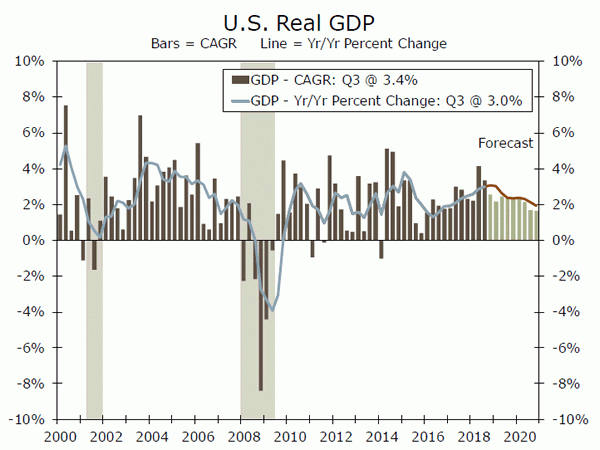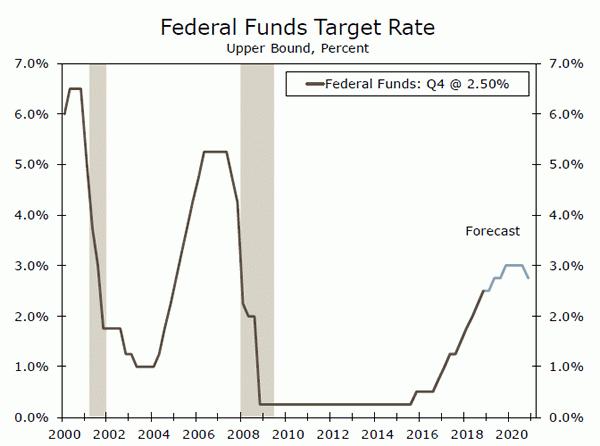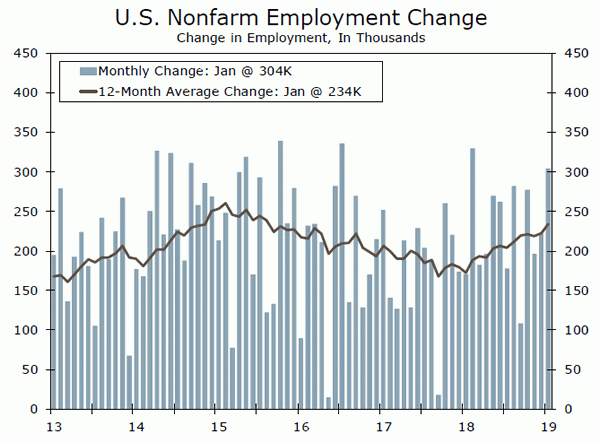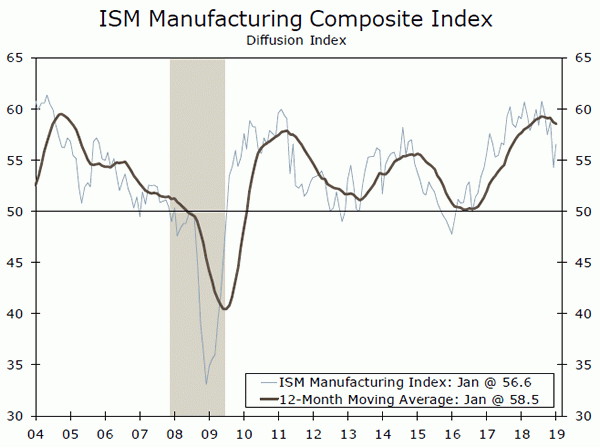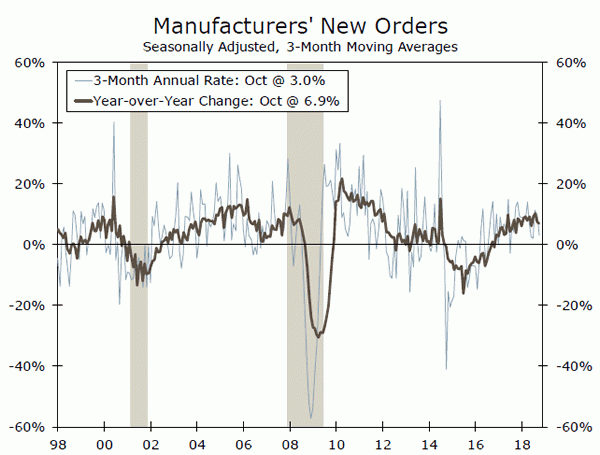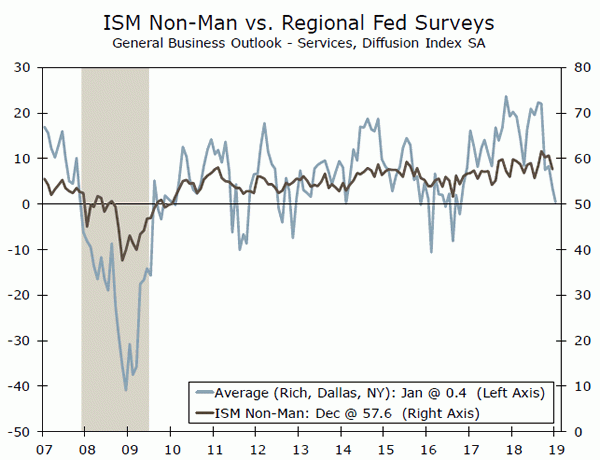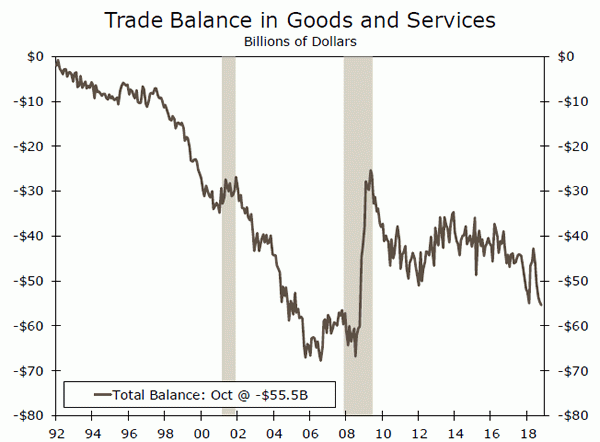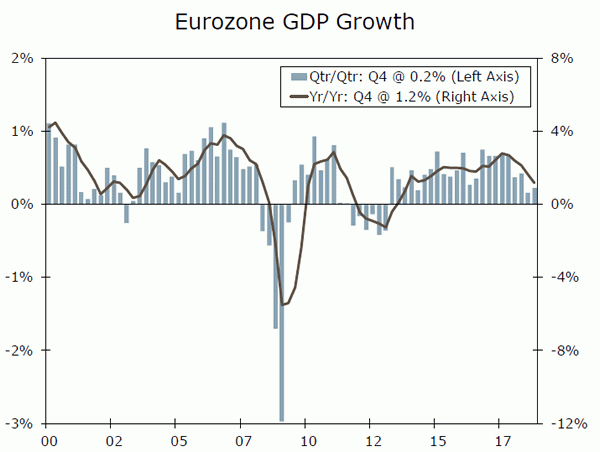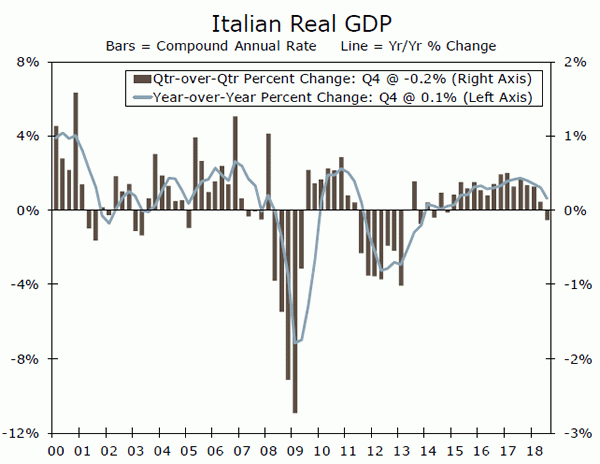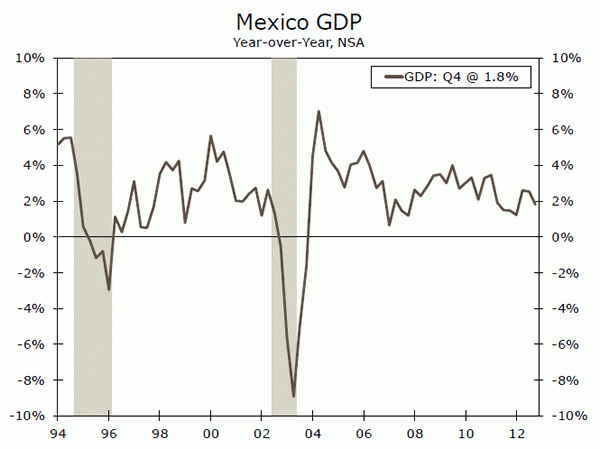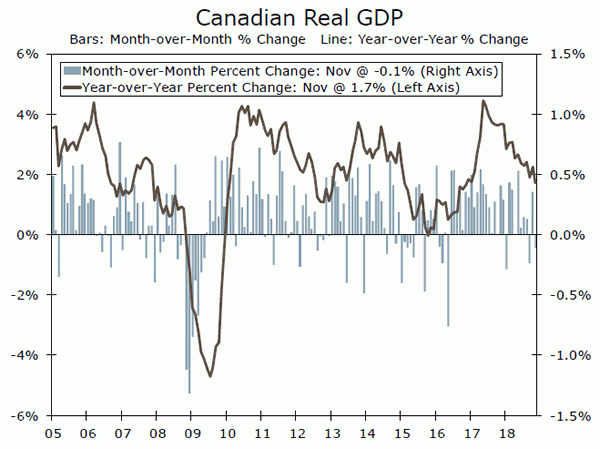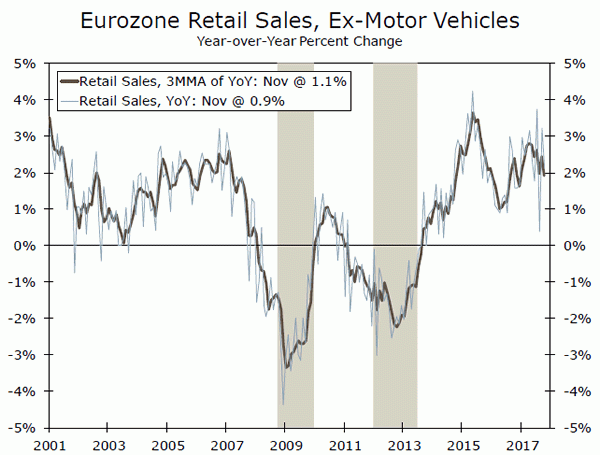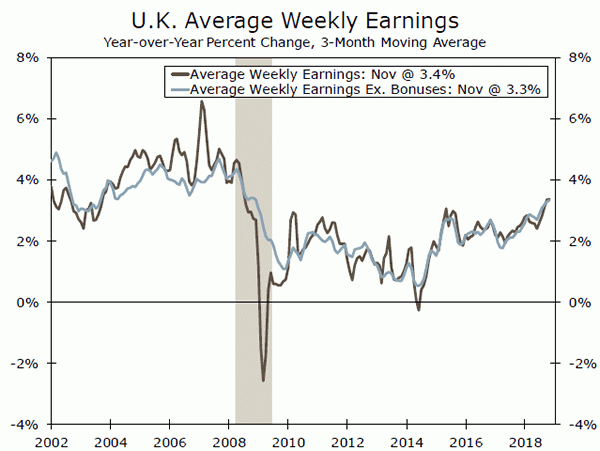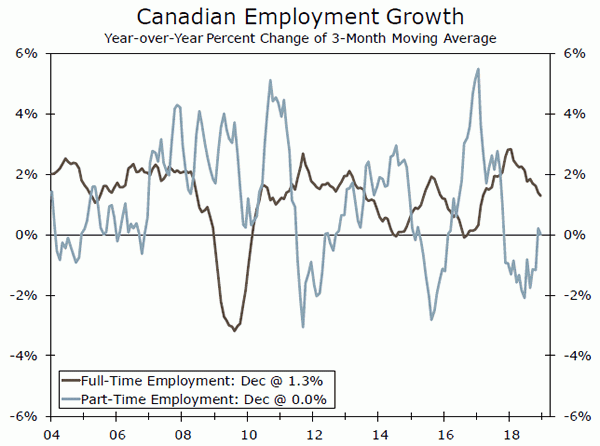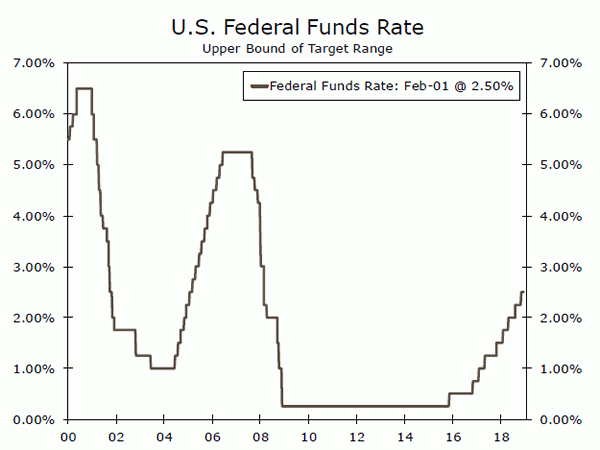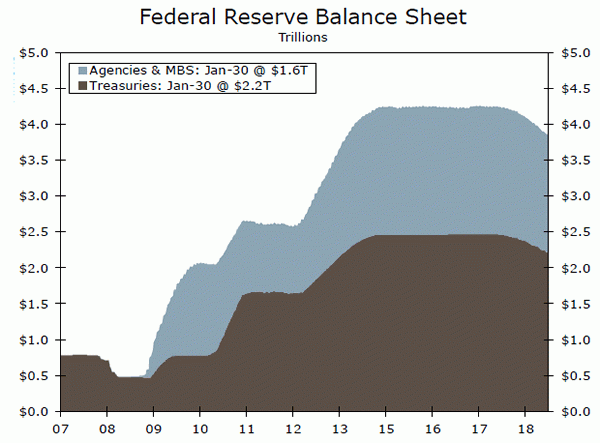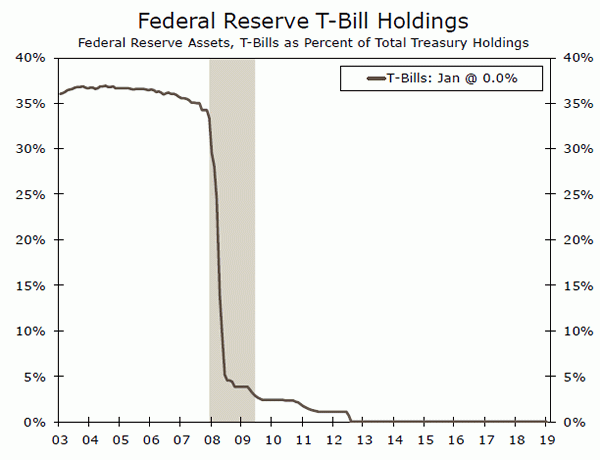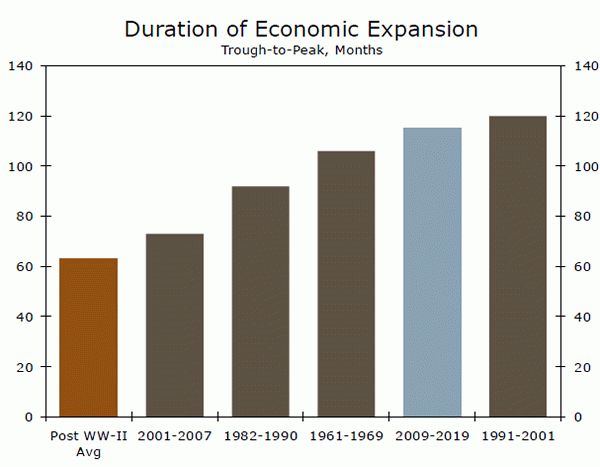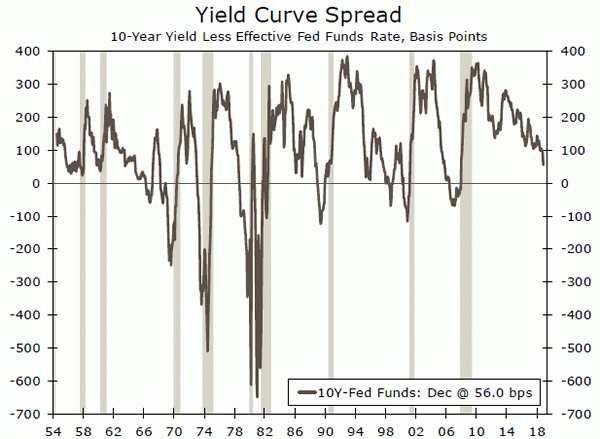U.S. Review
Growth Set to Moderate, Yet Continue
- With the government doors having re-opened on Monday, a more patient stance from the Fed and the 100th consecutive month of employment gains, developments have provided some comfort to fears of an impending recession.
- Our visibility of economic developments remains clouded by the continued delay of indicator releases, but with the data we have received, economic growth looks set to continue, albeit at a more moderate pace.
- Nonfarm payrolls added 304,000 jobs in January, but the trend is expected to slow over the course of this year as economic growth moderates.
Growth Set to Moderate, Yet Continue
The longest partial government shutdown on record came to an end this past weekend, but with only a tentative solution that funds the portion of the government that was closed until February 15. Based off of what has already transpired, we estimate that the shutdown will directly reduce real GDP growth in Q1-2019 by about 0.3 percentage points, with a rebound of a similar magnitude likely in Q2. While the environment remains uncertain, we direct interested readers to our update on the subject, which discusses some possible paths forward.
Later in the week, the Federal Open Market Committee (FOMC) held its first policy meeting of 2019. As was widely expected, and in what was a unanimous decision, the Fed decided to keep its target range for the fed funds rate unchanged at 2.25% to 2.50%. Perhaps the most notable takeaway was the generally dovish tone of the policy statement. The committee removed its forward guidance, and even added a key word to its outlook for policy; patient. The committee said it “will be patient as it determines what future adjustments to the target range” may be appropriate. We still look for the FOMC to hike rates 50 bps more in this cycle, once in June and another in H2-2019. For further reading on this topic, please see our Interest Rate Watch section on page 6.
Even with the government re-opening its doors on Monday, the release of economic data remains delayed. GDP and personal income are two of the indicators postponed this week, which continues to constrain our visibility of economic developments. With the data we have received, economic growth looks set to continue, albeit at a more moderate pace.
The U.S. Department of Labor has not been impacted by the shutdown, and thus arguably the most closely watched indicator was released on time today–nonfarm payrolls. Market participants were in store for a surprise this morning, with nonfarm payrolls having risen a whopping 304,000 in January. This surpassed analysts’ expectations, with the consensus estimate at an increase of only 165,000. But, the solid report came with a downward revision to December payrolls of about 90,000 jobs. The January gain in employment, nonetheless, provides support that economic growth remains stable. Overall, we expect the trend in hiring to slow as economic growth moderates and the tight state of the labor market makes it difficult to fill vacant positions. But, if employment gains remains steady, our current assumption of another rate hike in the first half of the year may not look all that unlikely, despite the Fed demonstrating it is on hold for the foreseeable future. One caveat to that interpretation, however, is the subdued gains in average hourly earnings and the lack of upward pressure on inflation.
Later this morning, we turned our attention to the manufacturing sector. The Institute for Supply Management (ISM) released its fresh survey data for January. The ISM manufacturing index rebounded to 56.6 in January, after posting its largest monthly decline since 2008 in December. While this rebound likely has allied fears of a rapid deterioration in the factory sector, the road for the manufacturing sector ahead remains a bumpy one.
U.S. Outlook
Factory Orders • Monday
Manufacturing activity appears to have softened over the past couple of months, with the ISM manufacturing index slipping to 56.6 from 58.8 as recently as November. Yet, survey data on the manufacturing sector had already been running ahead of “hard” data, making it unclear if actual orders have also been faltering or if the ISM has merely fallen back in line.
The November factory orders data were a causality of the government shutdown. Although dated at this point, the November factory orders data will help fill in the pieces about the degree to which the manufacturing sector is losing momentum. We estimate orders fell 0.5% in November on a nominal basis. Durable goods orders are already reported to have risen 0.8% in November. Orders for nondurables, however, the new information in this report, were likely hit by declining oil prices weighing down the value of petroleum-related products over the month.
Previous: -2.1% Wells Fargo: -0.5% Consensus: 0.3% (Month-over-Month)
ISM Non-Manufacturing • Tuesday
The ISM non-manufacturing index shed 2.4 points in December, indicating somewhat slower growth. That said, at 58.0, the index was consistent with the service sector expanding at a solid rate.
The January reading, however, is unlikely to paint as favorable a picture. The government shutdown likely hit the service sector particularly hard. Payment disruptions to contractors or businesses patronized by effected workers are expected to have weighed on sales and new orders. An average of Fed service-sector PMIs have come down sharply in recent months, including a 3-point drop in January.
A sharp pullback may not be too concerning for the Fed if details suggest it was attributable to the shutdown and therefore ripe for reversal over the next few months. Another strong print would be consistent with the economy motoring along despite recent headwinds, supporting further Fed tightening later this year. Previous: 58.0 Wells Fargo: 56.0 Consensus: 57.0
Trade Balance • Wednesday
Trade figures for November are to be released next week after a nearly one-month delay due to the partial government shutdown. In October, the trade deficit widened by $900 million to a total of $55.5 billion. We expect to see that reversed for November, with the deficit narrowing to $54.3 billion.
Nevertheless, the gap between imports and exports looks on track to be significantly wider in the fourth quarter. Continuing trade tensions are weighing on exports, particularly to China. At the same time, importers late in the year were likely trying to get ahead of potential tariff increases set for January. More fundamentally, solid U.S. consumer spending has supported demand for imported goods. We estimate trade will be a significant drag on fourth quarter GDP, which was originally scheduled to be released this past Wednesday.
Previous: -$55.5 Billion Wells Fargo: -$54.3 Billion Consensus: -$54.0 Billion
Global Review
Eurozone Economic Growth Remains Weak
- Data released this week showed the Eurozone economy grew just 0.2% on a sequential basis in Q4-2018, while the year-overyear pace of growth slowed to just 1.2%. Italy fell into recession, while the slowdown appears to be broadly based across various sectors of the economy.
- U.K. Parliament considered a number of paths forward for Brexit, but did not appear to be in favor of any proposals that were palatable to the European Union. Parliament is scheduled to vote on May’s deal again on February 14, and another failure to pass the deal could see the U.K. push for an extension of the March Brexit deadline.
Eurozone Growth Remained Soft in Q4
Data released this week confirmed that Eurozone economic growth remained soft at the end of 2018. Real GDP in the Eurozone rose just 0.2% on a sequential basis in Q4, while the year-over-year pace of growth eased to 1.2%, the slowest rate since 2013. Additional details on the slowdown are scant at this point, but the countrylevel data and higher frequency activity data offer some clues. A particular standout in the country-level data was Italy, which saw a 0.2% (not annualized) sequential drop in real GDP after a 0.1% decline in Q3, suggesting the economy fell into a technical recession in the second half of 2018. Meanwhile, data suggest the slowdown has been broadly based across sectors. In December, German retail sales fell 4.3% month over month, the largest decline since 2007, and French consumer spending fell 1.5% during the month. Meanwhile, activity figures in the industrial sector have also been worrying, as industrial output fell 1.7% month-overmonth in November after a 0.1% drop in the prior month. In short, the Eurozone is showing broad-based weakness, and the European Central Bank (ECB) has taken note. Last week, the ECB acknowledged that economic risks had moved to the downside, while policymakers have become more vocal in their concerns around the pace of economic growth. Accordingly, we have downgraded our GDP growth forecast for the Eurozone to 1.5% in 2019 and 1.4% in 2020. Meanwhile, we still see the first ECB rate hike in December, but are pushing back the timing of the following hike to June from March.
Elsewhere in Europe, U.K. Parliament held a series of votes on various paths forward for the Brexit process. The only proposal it approved was one aimed at sending Prime Minister Theresa May back to Brussels to renegotiate the Irish border backstop, and lawmakers voted against a proposal to delay the Article 50 deadline of March 29. However, E.U. policymakers have made it clear that they are unwilling to renegotiate the backstop, and prefer instead to consider a delay in the March deadline. In other words, the U.K. and E.U. are on entirely different pages. Ultimately, we expect something very close to May’s current withdrawal deal to be passed by U.K. Parliament—the only question is timing. May is expected to hold another vote on her deal on February 14, and if the deal is not approved this time, the U.K. might capitulate and ask for an extension of the March deadline as far as July.
Turning back to global economic data, the news were fairly mixed this week. Mexico’s Q4 GDP growth figures surprised to the downside, as the year-over-year pace of growth slowed to 1.8%. Meanwhile, Canada’s GDP figures printed largely as expected, with a 0.1% sequential drop in November. Canadian GDP growth has clearly slowed in recent months, and the drop in oil prices has likely played a role. Last but not least, China’s January PMI figures were a bit better than expected—the manufacturing PMI stayed below 50 but unexpectedly ticked higher to 49.5, while the services PMI climbed to 54.7. We still look for Chinese economic growth to slow going forward, but reasonably stable sentiment figures, particularly in the services sector, suggest a collapse in activity is not imminent.
Global Outlook
Eurozone Retail Sales • Tuesday
Eurozone economic weakness has been a key theme in recent months, and one that has garnered the attention of European Central Bank (ECB) policymakers. At the latest ECB policy announcement, the statement acknowledged that economic risks have moved to the downside, while there has been increasing talk of a potential economic recession in the Eurozone.
Along those lines, recent data from the consumer sector have been discouraging. In December, German retail sales plunged 4.3% month over month, while French consumer spending fell 1.5% during the month. These sharp declines in consumer activity suggest risks are to the downside for next week’s Eurozone retail sales print, which will likely only add to ECB policymakers’ concerns around the slowdown in activity in the currency bloc.
Previous: 0.6% Consensus: -1.6% Month-over-Month
Bank of England • Thursday
The Bank of England (BoE) has been firmly on hold since August against a backdrop of uncertainty over Brexit. However, there have been increasing signs of building price pressures within the U.K. economy, and BoE policymakers have taken note. It is our sense that were the cloud of Brexit uncertainty not hanging over the U.K. economy, the BoE likely would have raised rates an additional 25 bps since August to stave off incipient wage and broader inflation pressures.
We remain of the view that the BoE will raise rates twice this year, a view that is predicated on a smooth resolution to Brexit uncertainty by the March 29 deadline. However, a delay in the Brexit process could lead us to change that view to one or zero rate hikes, unless a decisive plan emerges within the U.K. government to resolve Brexit uncertainty.
Previous: 0.75% Wells Fargo: 0.75% Consensus: 0.75%
Canada Employment • Friday
Canada’s economy has showed signs of weakening in recent months, including slowing activity in the retail and industrial sectors alike and a drop in economic sentiment. Labor market developments have been more mixed. Headline employment growth has remained solid, but full-time employment growth has slowed. Softer full-time job growth has coincided with a weakening in wage growth, while the unemployment rate has fallen rather markedly in recent months.
On balance, we still see Canada’s labor market as fairly healthy, and see the economy growing around trend in 2019. Against that backdrop, we look for the Bank of Canada (BoC) to hike rates twice this year. In evaluating next week’s Canadian jobs report, we see the wage figures as just as important, if not more important, in considering the path forward for the BoC. Some stabilization or a rebound in wage growth is likely a necessary, but not sufficient, condition for further BoC rate hikes in the quarters ahead.
Previous: 9.3K Consensus: 10.0K
Point of View
Interest Rate Watch
FOMC Says It Can Be “Patient”
As widely expected, the Federal Open Market Committee (FOMC) decided this week to keep its target range for the fed funds rate unchanged at 2.25% to 2.50% (top chart). In addition, the committee removed its forward guidance by which it had indicated that “some further gradual increases in the target range for the federal funds rate” would be needed. The FOMC now says that it can be “patient” as it determines what future adjustments to the target range for the federal funds rate may be appropriate. In short, the Fed is on hold for the foreseeable future. Although we forecast that the FOMC will opt to tap on the brakes again (i.e., raise rates by 25 bps) this summer and again at the end of the year, it appears that short-term interest rates likely will remain more or less unchanged over the next few months.
In a separate statement, the FOMC announced that it had decided to maintain the current monetary policy operating framework that it has employed for the past ten years. As we noted in a recent report, the Fed now relies on administered rates to control the fed funds rate rather than the old system in which it added or drained reserves on a daily basis in an effort to hit its target. The implications of this decision is that the Fed’s balance sheet will not shrink back to its pre-crisis level (middle chart). As we pointed out in two reports we wrote last summer (Part I and Part II), a large Fed balance sheet means that long-term interest rates likely will be lower than otherwise, everything else equal. This operating framework gives the Fed the flexibility to return to quantitative easing again once interest rates are cut to essentially zero percent, should that prove necessary at some point in the future.
The FOMC has not yet indicated, however, when the shrinkage of the balance sheet would come to an end. In the meantime, we suspect the gradual shrinkage that has been occurring since the end of 2017 will proceed in more or less a mechanical fashion for the foreseeable future. The FOMC also did not address the future composition of the asset side of its balance sheet. But as we have written previously, we suspect the Fed will let its holdings of mortgage-backed securities continue to run off in favor of holding T-bills once again (bottom chart).
Credit Market Insights
Shadow Mortgages?
The former head of Ginnie Mae (GNMA) called it “the biggest shift in mortgage lending since the savings-and-loan debacle in the 1980s.” The growing role of nonbank lenders in the mortgage market has caught the eye of officials from GNMA as well as the Federal Reserve, including Chairman Powell. Non-bank lenders composed nearly 80% of total issuance of GNMA-backed mortgage securities in FY 2018, up from 51% in FY 2014. These smaller, non-bank lenders rose in prominence after the financial crisis as banks retreated from the mortgage market and have stayed on the sidelines as the housing sector gradually recovered.
The surge in non-bank mortgage origination has taken place entirely during a period of economic growth and steady, albeit gradual, improvement in the housing market. This has raised concerns over the resilience of these firms during a period of stress. Nonbanks do not take deposits, typically have weaker balance sheets and generally rely on short-term financing from banks that could dry up if delinquencies were to spike. Moreover, non-bank lenders rely relatively more heavily on refinancing fees and activity, which have declined amid higher mortgage rates. As a result, GNMA has recently begun the process of stress testing these entities, and has even gone as far as to request improvements to specific financial metrics before granting full backing of mortgage securities. Delinquency rates remain very low for now, but regulators are increasingly monitoring the non-bank sector’s role in mortgage origination.
Topic of the Week
Dating Advice
Since 1945 there have been 12 U.S. recessions that have lasted, on average, 10.8 months. Add up the duration of every post-war recession and you get 130 months, or just shy of 11 years. That is less than 15% of the time. Said differently, 85% of the time the economy is in expansion. The average expansion during that same time period is just under five years, and the longest (1991-2001) was 120 months (top chart). If the U.S. economy is still in expansion in July as we expect it to be, this will become the longest U.S. economic expansion on record.
The length of this expansion alone implores a hard look at when the next recession may strike. More crucially, sailing is anything but smooth at present. Risks are mounting and early warning signals of a recession keep popping up. Global growth is slowing. The world’s most influential central bank, the Fed, is teetering on restrictive monetary policy. U.S. policy uncertainty is at a five-year high amid ongoing trade disputes and only tentative resolution to the government shutdown. The leading economic index, a key yardstick for the direction of the economy, is losing momentum. Perhaps most ominously, an inverted yield curve has preceded each of the past seven recessions, and we are uncomfortably close to inversion again (bottom chart).
So what defines recession and what should we be watching? The official call is up to the National Bureau of Economic Research (NBER), whose dating committee determines the start and end dates for each cycle. It considers recession to be “a significant decline in economic activity…normally visible in real GDP, real income, employment, industrial production, and wholesale-retail sales.”
In a series of notes this past week, we have unpacked each of these components. None of these four horsemen of the apocalypse are signaling recession yet. But what do the leading indicators for each signal in light of the gathering clouds? The next recession is coming, it is just a question of when. These reports will help you identify the leading indicators to watch. Dating the economic cycle is not easy; these reports are our best advice.




